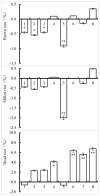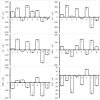Silicon and Zinc Fertilizer Application Improves Grain Quality and Aroma in the japonica Rice Variety Nanjing 46
- PMID: 38201181
- PMCID: PMC10778609
- DOI: 10.3390/foods13010152
Silicon and Zinc Fertilizer Application Improves Grain Quality and Aroma in the japonica Rice Variety Nanjing 46
Abstract
This study examined how silicon and zinc fertilizers affect the quality and aroma of Nanjing 46. We applied nine different fertilizer treatments, one involving soil topdressing at the top fourth leaf-age stage and one involving foliar spraying during the booting stage of the silicon and zinc fertilizers. We tested the effects of the nine treatments on grain quality and aroma. Silicon and zinc fertilizers significantly affected the brown rice rate, milled rice rate, head rice rate, amylose content, gel consistency, RVA characteristic value, taste value, and aroma but did not affect the chalky grain rate, chalkiness, protein content, rice appearance, hardness, stickiness, balance, peak time, or pasting temperature. Silicon fertilizer decreased the rate of brown rice and milled rice, whereas zinc fertilizer increased the rate of brown rice and milled rice. Silicon and zinc fertilizers improved the head rice rate. Compared to silicon fertilizer, the impact of zinc fertilizer on increasing the head rice rate was more pronounced. Although the effects of silicon and zinc fertilizers on the amylose content and RVA characteristic value varied depending on the treatment, their application could lower the amylose content, increase gel consistency, improve breakdown viscosity, decrease setback viscosity, increase aroma, and improve the taste value of rice.
Keywords: aroma; grain quality; rice; silicon; zinc fertilizer.
Conflict of interest statement
The authors declare that they have no competing interests.
Figures



Similar articles
-
Moderate Nitrogen Application Synergistically Improved Yield and Quality of Nanjing Series japonica Rice Varieties with Good Taste.Plants (Basel). 2025 Mar 17;14(6):940. doi: 10.3390/plants14060940. Plants (Basel). 2025. PMID: 40265843 Free PMC article.
-
[Effects of nitrogen fertilizer application rate on nitrogen use efficiency and grain yield and quality of different rice varieties].Ying Yong Sheng Tai Xue Bao. 2017 Apr 18;28(4):1219-1226. doi: 10.13287/j.1001-9332.201704.010. Ying Yong Sheng Tai Xue Bao. 2017. PMID: 29741319 Chinese.
-
[Response of yield, quality and nitrogen use efficiency to nitrogen fertilizer from mechanical transplanting super japonica rice].Ying Yong Sheng Tai Xue Bao. 2014 Feb;25(2):488-96. Ying Yong Sheng Tai Xue Bao. 2014. PMID: 24830250 Chinese.
-
Effects of topdressing silicon fertilizer at key stages on uptake and accumulation of arsenic in rice.Environ Sci Pollut Res Int. 2023 Mar;30(11):31309-31319. doi: 10.1007/s11356-022-24365-y. Epub 2022 Nov 29. Environ Sci Pollut Res Int. 2023. PMID: 36445527
-
Improving Rice Grain Quality Through Ecotype Breeding for Enhancing Food and Nutritional Security in Asia-Pacific Region.Rice (N Y). 2024 Aug 5;17(1):47. doi: 10.1186/s12284-024-00725-9. Rice (N Y). 2024. PMID: 39102064 Free PMC article. Review.
Cited by
-
Application of Silicon Influencing Grain Yield and Some Grain Quality Features in Thai Fragrant Rice.Plants (Basel). 2024 May 12;13(10):1336. doi: 10.3390/plants13101336. Plants (Basel). 2024. PMID: 38794407 Free PMC article.
References
-
- Chen S.H. Centennial development and Prospect of rice breeding in China. China Rice. 2021;27:1–6. (In Chinese with English abstract)
-
- Wang C.L. China Rice Varieties, Jiangsu Volume. In: Wan J.M., editor. China Rice Varieties. China Agricultural Press; Beijing, China: 2018. pp. 13–32. (In Chinese)
-
- Wang C.L., Zhang Y.D., Zhao C.F., Wei X.D., Yao S., Zhou L.H., Zhu Z., Chen T., Zhao Q.Y., Zhao L., et al. Inheritance and breeding of japonica rice with good eating quality in Jiangsu province. Hereditas. 2021;43:442–458. (In Chinese with English abstract) - PubMed
-
- Wang C.L., Zhang Y.D., Zhu Z., Zhao C.F., Wei X.D., Chen T., Zhao Q.Y., Zhao L., Yao S., Zhou L.H., et al. Development and application of quality standard for semi glutinous japonica rice with good taste. Jiangsu J. Agric. Sci. 2022;38:1–8. (In Chinese with English abstract)
Grants and funding
LinkOut - more resources
Full Text Sources

